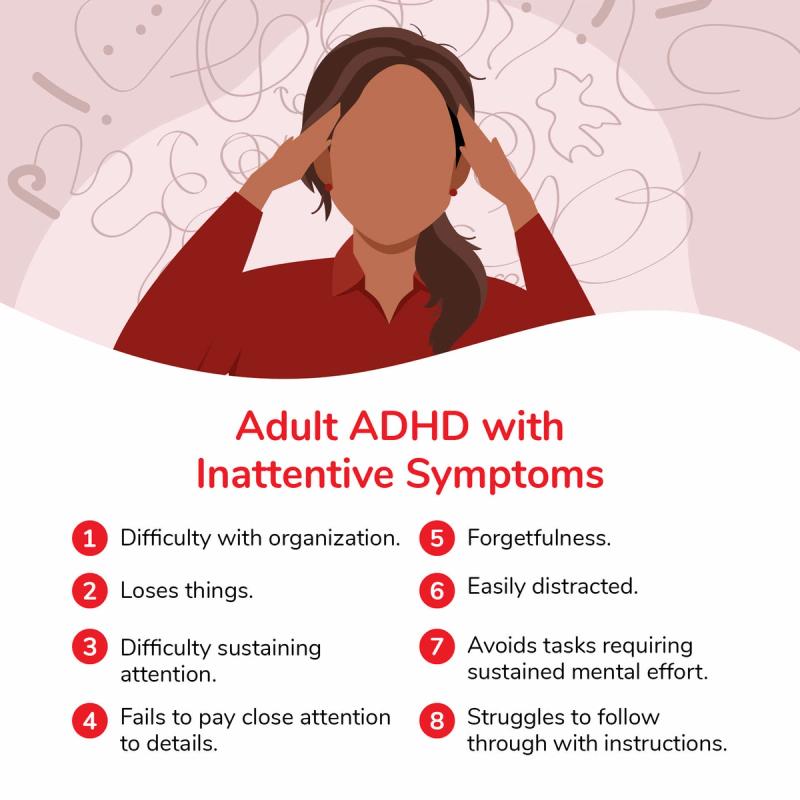- November 26, 2024
Inattentive ADHD

Inattentive ADHD, a subtype of attention-deficit/hyperactivity disorder (ADHD), is characterized by difficulty concentrating, maintaining focus, and staying organized. Unlike the hyperactive form of ADHD, individuals with this type often lack symptoms of excessive physical movement or impulsivity.
Common Characteristics of Inattentive ADHD:
- Trouble paying attention to details.
- Easily distracted by surroundings or thoughts.
- Struggles with time management and completing tasks.
- Forgetting routine responsibilities such as chores, bills, or appointments.
These challenges often disrupt daily life, affecting school, work, relationships, and overall quality of life. However, treatment options are available for children and adults alike.
Prevalence
Inattentive ADHD is the most common form of ADHD, impacting millions of people worldwide.
Symptoms
Individuals with inattentive ADHD may experience:
- Frequent errors in detail-oriented tasks.
- Difficulty maintaining focus on sustained activities like reading or presentations.
- Trouble listening during conversations.
- Losing track of tasks, deadlines, or obligations.
- Struggles with time management and organization.
- Forgetting or misplacing everyday items like keys, phones, or wallets.
- Difficulty staying present, easily succumbing to distractions.
While occasional lapses in attention are normal, people with inattentive ADHD experience these issues persistently, causing significant disruption in their daily lives.
Causes and Risk Factors
The exact cause of inattentive ADHD remains unclear, though research points to several contributing factors:
- Genetics: ADHD often runs in families.
- Brain structure and function: Certain anatomical differences may play a role.
- Prenatal factors:
- Exposure to alcohol, tobacco, or substances during pregnancy.
- Environmental toxins, such as lead exposure.
- Preterm birth or low birth weight.
Complications
Inattentive ADHD can lead to significant challenges, including:
- Missed deadlines or tardiness.
- Disorganized living or workspaces.
- Lost or misplaced items.
- Difficulty maintaining social connections and relationships.
- Safety risks in high-stakes environments requiring focus.
Social and emotional consequences, such as being mislabeled as “lazy” or “careless,” can harm self-esteem and mental health, exacerbating feelings of frustration or alienation.
Diagnosis and Testing
There is no single test for inattentive ADHD. Instead, diagnosis involves:
- Detailed evaluations of symptoms by a psychiatrist, psychologist, or neurologist.
- Reviewing personal and family medical history.
Can Adults Be Diagnosed?
Yes. Although ADHD symptoms typically appear in childhood, inattentive ADHD often goes undiagnosed until adulthood, especially since hyperactivity is not a symptom of this subtype.
Adults may notice struggles such as:
- Losing focus in work or academic settings.
- Difficulty maintaining organized spaces or schedules.
- Persistent forgetfulness, leading to missed commitments.
- Relationship strains due to impatience or distraction.
In some cases, adults seek a diagnosis after recognizing similar patterns in their children, prompting both parent and child to seek professional help simultaneously.
Living with Inattentive ADHD
While inattentive ADHD presents unique challenges, it does not define your intelligence or abilities. With proper diagnosis, support, and treatment, individuals can develop strategies to manage symptoms and thrive.

